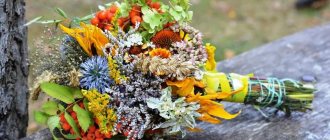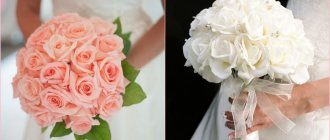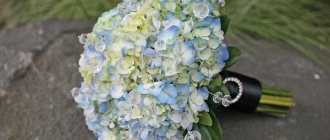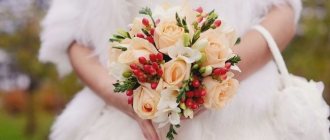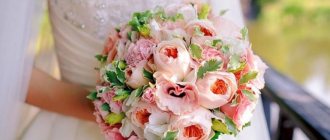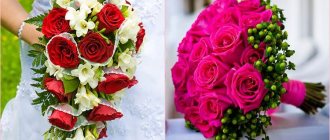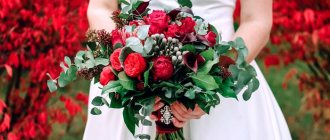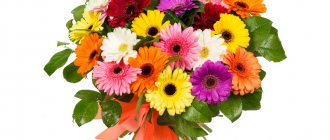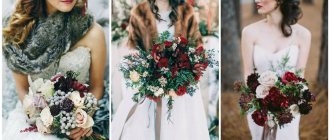A wedding is the most important event in the life of lovers, and a lot of effort goes into organizing it. Selecting the image of young people is the most sensitive task, requiring careful thought through all the nuances. Therefore, the bride’s bouquet should match the bride’s outfit as much as possible. An excellent option would be a wedding bouquet of daisies. We will consider further which flowers will look advantageous in tandem, and which ones will emphasize the tenderness of the wedding ceremony.
Features of daisies
Content
This plant can be called universal, as it can harmoniously complement almost any flower arrangement and be suitable for any occasion. A bride's bouquet of daisies will be an excellent addition to the wedding image, which will highlight all the best features of the girl and make her unique.
The peculiarity of daisies is that its delicate tones are perfect for a traditional wedding ceremony and will harmoniously fit into the image of the newlyweds.
How to do it yourself?
This question is quite complex, since the process largely depends on the plants available. Below are two options for compositions - based on summer meadow flowers (partially cultivated) and using ears of corn.
The first master class shows the spiral technique. In fact, the bouquet is collected from the middle, from the tallest plants. It is not necessary to arrange all the flowers sequentially - first some, then others, others... they can be alternated.
The basic principle: plants are gradually added to the initial two to five branches, gradually reducing the height of the composition and taking care that the flowers do not interfere with each other. The ends of the stems are trimmed after the final assembly and fastening of the branches.
The second option is also a spiral technique, in which the ends of the stems form a diverging cone. Here green branches alternate with fruits and dried ears.
With any type of bouquet, even from dried flowers, it is necessary to protect the bride’s hands from contact with stems and branches. To do this, it is advisable to wrap the place of fastening with beautiful paper, fabric, ribbon, lace - any suitable material that is pleasant to the touch. It is also a good idea to hide the lower part of the composition in a bag or wrapper or basket.
In addition to purely aesthetic considerations, this will allow the lower parts of the stems to be placed in a floral sponge with a preservative composition. Special holders for sponges are very convenient for assembly, as shown in the photo below.
Suitable bouquet shapes
Chamomile does not have a strictly defined shape, like, for example, a rose and its petals. This should be taken into account when choosing the shape of the bouquet. It is recommended to combine with other colors and make an ensemble out of them based on size and variety.
Chamomiles with large inflorescences and a wide core will look harmonious and original in the classic shape of a wedding bouquet - a hemisphere. The flowers, quite tightly adjacent to each other, form an elegant “meadow”, which would be appropriate to highlight with a pastel-colored satin ribbon wrapped around the stems.
Varieties with smaller inflorescences will look better “discordantly”, with a little natural negligence. Also, small flowers will ideally complement larger ones - roses, gerberas or chrysanthemums, which look good in a spherical shape.
Botanical certificate
It would seem that when creating a beautiful arrangement, it is important to follow the rules of floristry, and not be interested in the scientific description of a particular plant. But it is necessary to delve deeper into the terminology, since not all flowers, colloquially referred to as “daisies,” are actually such. And the care for it and the selection of “companions” for the bouquet depend on which plant is used.
Chamomile (lat. Matricaria) is a herbaceous flowering perennial from the Asteraceae family. There are about 20 varieties of this field plant. The most famous of them is chamomile (Matricaria chamomilla), actively used in folk and traditional medicine. It is easily recognized by its low stem with numerous shoots covered with small baskets of inflorescences and sparse, heavily dissected leaves.
Matricaria looks harmonious in field compositions, where it fully reveals its discreet beauty. Like many herbs, it wilts quickly when cut. But wedding florists love this flower, because from just a few branches you can create a lush bridal bouquet - airy and delicate, like a cloud. To extend the life of this ephemeral creation, they try to seal it with water with the addition of aspirin and charcoal as soon as possible. However, field chamomile has relatives from the Astrov family, which are more durable and can replace the original, maintaining the declared “rustic chic”.
Nivyanyk
Flowers that are sold under the guise of large garden daisies are leucanthemum. Breeders have long appreciated its size and decorative value, so they have developed many new varieties, including those with double inflorescences. The largest cornflower with a basket diameter of up to 12 cm is often found in gardens. Its complex structure resembles anemone-like chrysanthemums.
Varietal cornflower tolerates cutting well and lasts a long time in arrangements. It is ideal for a country wedding, combining well with sunflowers, chrysanthemums, garden cornflowers, berries, fruits and cereals.
Pyrethrum coryptosum
It is difficult for the untrained eye to distinguish the differences between this variety of tansy (Pyrethrum corymbosum) and the usual matricaria. The same small flowers with a yellow core and a “skirt” of white petals, pinnately dissected leaves, and an upward branched trunk. However, tansy is a long-liver of any bouquet and does not require special care, unlike fragile chamomile.
In decorative floristry, only garden varieties of pyrethrum scutellum are used. Wild flowers are listed in the Red Book of many regions of Russia.
Dendtratheme
The ancestor of hybrid chrysanthemums, Dendranthema, is often cultivated by gardeners today. It not only decorates flower beds, but is also eaten, especially in Japan and East Asian countries. With proper care, cut chrysanthemums can last up to 20 days, and dendrathema is no exception. It will fit perfectly into a rustic style bridal bouquet, which can be complemented with a wreath - a fashionable alternative to a tiara.
At winter weddings, small white bush chrysanthemums are used, which are called chamomile (sometimes daisy-shaped). Unlike other Matricaria "look-alikes", they are available year-round and are frost-resistant enough to withstand a brief bridal stroll during an outdoor photo shoot.
Bouquet options
The combination of chamomile with many plants does not limit the choice of additional accessories to create wedding floral decorations and the bride’s outfit. Variations of bouquets will be a beautiful addition to the bride’s image.
When choosing an ensemble of daisies, you should not wear a too flashy and pretentious wedding dress with a lot of rhinestones or beads. A simple wildflower will ideally complement a discreet and classic wedding outfit, standing out harmoniously against its background. Another advantage of this flower is its availability. Long flowering in the summer will allow you to enjoy daisies and even make a bouquet with your own hands.
Various varieties and their differences
Florists use about 15 species in their work, and this is more than enough to create original bouquets. At your choice, chamomile with:
- large basket
- small basket
- small, almost round petals
- wide, long, pointed or rounded petals
- different thickness and height of the stem
The only thing that limits the bride's choice is color. The petals are always white. All the so-called “multi-colored daisies” are completely different flowers. Although many of them combine perfectly with their white counterparts, creating an exclusive composition worthy of the hands of a charming bride. But we'll talk about this a little later.
Decorations
The bride's accessories must match the wedding dress and the overall idea. Jewelry with pearls or beads will look perfect with a bouquet of daisies. The bouquet itself can be decorated with sprigs of greenery or spikelets. To preserve its natural charm, it is recommended to wrap the stem of the bouquet with a light green, yellow or milky color ribbon, optionally decorating it with mother-of-pearl beads.
The choice of field daisies for a wedding bouquet can be considered very successful, since these are the flowers of lovers. Daisies will harmoniously complement the bride's wedding image, emphasizing her beauty, youth and tenderness.
Successful decorative elements
The beauty of this flower is in its simplicity. If you choose a decoration for such a bouquet, then it should be as discreet as possible - to emphasize, and not to overshadow.
A good solution is a flat bow made of a wide golden ribbon on stems. You can wrap the stems with ribbon (preferably yellow if there are only daisies in the bouquet, if not, match the color of other compositional components) and sew small beads vertically in one row.
The best decor option for a bouquet is greenery, such as asparagus, shepherd's purse or cordyline.
Under no circumstances should you “plant” butterflies, hearts and other decorative elements on long wires on flowers. Firstly, it is unsafe for the bride, and secondly, it will greatly vulgarize the composition and spoil the charm of this modest flower.
Another great flower that is ideal for a wedding bouquet is freesia.
Color meaning
Red in most cultures is associated with passion and the feeling of love. It is also a sign of security.
Shades of red also have their meaning. Rich scarlet signifies the passionate side of love experiences, and burgundy is a sign of respect.
In Eastern countries, this tone is associated with summer heat and activity. Is the embodiment of male energy. At the same time, it remains the most common color of brides’ dresses, who choose it as a sign of good luck and fertility.
In Rus', red meant the same thing as beautiful, and was a reflection of the feminine essence. It was believed that it protected its owner from negative energy attacks.
And also we should not forget about the meaning of red in Christianity. This is a sign of the shed blood of Christ.
Symbolism
When choosing flowers, it is important to take into account not only your tastes, colors and their appearance, but also the symbolism of the plants.
According to legend, cornflowers owe their powerful energy to a young man who collected bouquets of blue flowers in every meadow until his power settled in them. Cornflower is considered the embodiment of purity, grace and modesty, and its blue color is a symbol of devotion and constancy. The flower radiates the energy of friendliness and tenderness.
The color blue is endowed with special power, so the union of two lovers should be strong, designed to last for many years. Advice! This bouquet is suitable for a wedding in a folk or French style. It will add intrigue to the bride's image, shrouding it in a soft aura of mystery.
Matching the wedding dress, season, style of celebration
First of all, such a bright composition will be appreciated by calm and confident girls, who nevertheless know how to dream and love romance.
Celestial shades combine perfectly with blue-eyed beauties - the accessory will highlight the enchanting eye color, adding depth and richness to it. Due to its versatility and existence in both warm and cool tones, blue will wonderfully highlight any color type.
The color will also appeal to girls who want to create an interesting, memorable accent, but to those who don’t really like flashy tones, because blue, despite all its strength, is quite soft and elegant.
A blue bouquet is suitable for a wedding planned for any season:
- in summer the shade will create a breath of freshness, dispersing the heat;
- in spring it will reveal its radiant, youthful and playful side;
- in the fall it will remind you of peace and well-being;
- in winter it will wonderfully dilute the snow-white surrounding monochrome.
Such a bouquet is indispensable at a themed wedding in a nautical, Greek, fairy-tale-winter style and when using rich blue or light blue shades in the decor of the room, as well as in the makeup and accessories of the hero of the occasion. The blue composition goes perfectly with classic outfits - A-line, full skirts, necklines, but for each style you need to choose a specific bouquet shape.
What does the rose symbolize?
The bride's bouquet is not only one of the details of the image, but also a certain symbol of the event. Depending on what flowers are included in the composition, one can judge the character of the bride and her attitude towards the groom.
The rose is a symbol of perfection, passion, fertility and eternity
The rose has several symbolic meanings. They differ in different countries and situations. In the West, the rose has a meaning similar to the lotus in India and China. In other words, the plant symbolizes purity, sensuality, but at the same time the center of the universe and divinity. The flower also has the meaning of ideality, completeness and nobility .
Bouquet of roses for the bride and ring
For a long time, the phrase “strew the path with roses” means removing all obstacles , making the road easy and happy . In addition, the plant has the meaning of concentration, intelligence and caution.
The ancient Romans believed that roses prevent unnecessary conversations and promote the ability to remain silent. That is why garlands of these flowers were hung in the halls where feasts or meetings were held.
Bouquet of purple roses for the bride
This kind of symbolism is not found these days. In most cases, brides choose the design of their bouquet based on their preferences and the style of the entire wedding.
How to do it yourself?
This question is quite complex, since the process largely depends on the plants available. Below are two options for compositions - based on summer meadow flowers (partially cultivated) and using ears of corn.
The first master class shows the spiral technique. In fact, the bouquet is collected from the middle, from the tallest plants. It is not necessary to arrange all the flowers sequentially - first some, then others, others... they can be alternated.
The basic principle: plants are gradually added to the initial two to five branches, gradually reducing the height of the composition and taking care that the flowers do not interfere with each other. The ends of the stems are trimmed after the final assembly and fastening of the branches.
The second option is also a spiral technique, in which the ends of the stems form a diverging cone. Here green branches alternate with fruits and dried ears.
With any type of bouquet, even from dried flowers, it is necessary to protect the bride’s hands from contact with stems and branches. To do this, it is advisable to wrap the place of fastening with beautiful paper, fabric, ribbon, lace - any suitable material that is pleasant to the touch. It is also a good idea to hide the lower part of the composition in a bag or wrapper or basket.
In addition to purely aesthetic considerations, this will allow the lower parts of the stems to be placed in a floral sponge with a preservative composition. Special holders for sponges are very convenient for assembly, as shown in the photo below.
Summary
So, a chamomile bouquet is a universal solution, suitable for almost any wedding and meeting the requirements of even the most capricious bride. Such a bouquet will look especially impressive at a summer wedding organized outdoors - in a forest clearing or in a chamomile field. If you are not planning this kind of holiday, then at least conduct a photo shoot a la naturel. Against the backdrop of summer greenery and flowering fields, your photos will turn out incredibly bright and will delight you with pleasant memories for the rest of your life.
admin 115
Previous article
Make it before winter. Wedding in November 2022: favorable days, signs and lunar calendar
Next article
What kind of brides are they suitable for?
A bouquet of cornflowers is an ideal option for fragile and timid girls. It is more suitable for young ladies, especially in combination with daisies, when it emphasizes the purity of the bride and the richness of her inner world.
Compositions made from cornflowers will fit perfectly into the image:
- blue-eyed or gray-eyed girls, helping to make their eyes more expressive;
- connoisseurs of everything natural and natural;
- owners of milky-white skin color;
- blondes, fair-haired or red-haired beauties;
- romantic and dreamy natures;
- those who like to attract attention;
- very young brides;
- women over 30.
Wildflowers evoke charm and admiration at the same time. They are liked by noble natures who are able to maintain love for one person throughout their lives. Such girls do not agree to adventures, prefer peace and family comfort, and have the ability to appreciate and understand themselves and their partner.
Useful video: master class
A beautiful chamomile bouquet is easy to assemble with your own hands. You can use regular daisies or chrysanthemums similar to these wonderful flowers (bacardi chrysanthemums). Watch the video for more details:
For a ball-shaped bouquet of these flowers you will need the following materials:
- Portable holder-microphone;
- water;
- scissors or pruning shears;
- Bacardi chrysanthemums (4-5 branches);
- a sprig of September flowers;
- glue for fresh flowers;
- glue gun;
- white beads;
- satin ribbon;
Place the porta bouquet in a bowl of water. There is no need to press it down; the sponge itself will absorb the required amount of water. Trim chrysanthemums diagonally - the stem and bud should be approximately 10 cm in length. Remove excess leaves from the stems. As you prepare the flowers, place the stems in water. When the porta bouquet is saturated with water, carefully insert the chrysanthemums into it - you should get a flower ball. Dilute the composition of daisies with September flowers. Using glue, attach several beads to the flowers. There is no need to overload the bouquet, but a light scattering of such white droplets will make the bouquet even more delicate and add charm to it.
Interesting! Pay attention to bouquets in which sunflowers or cornflowers play a key role.
Using a glue gun, wrap the stem of the bouquet with ribbon (you can use lilac, to match the September flowers). Cut the edges of the ribbon at an angle and tie it with a bow.
The bouquet is ready! He turned out to be sweet, touching and discreet. Making such a composition will not require much time and money.
